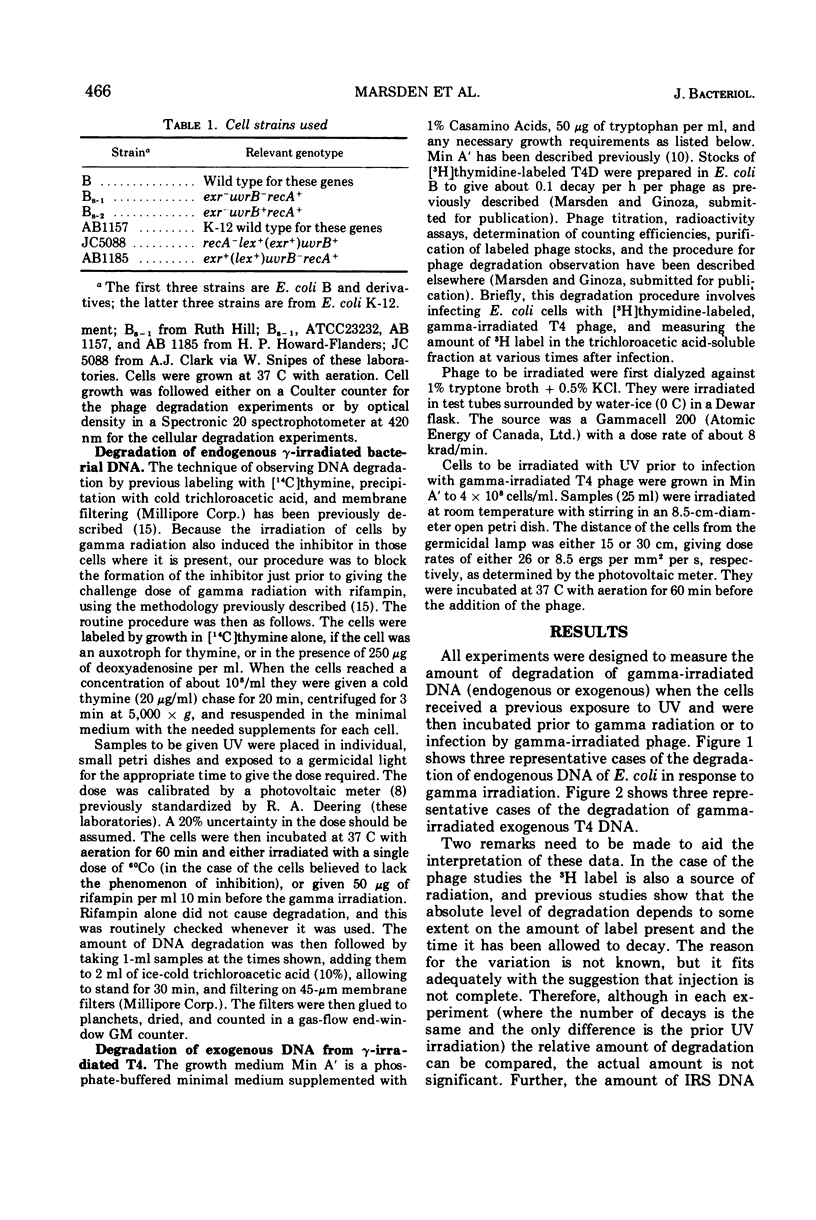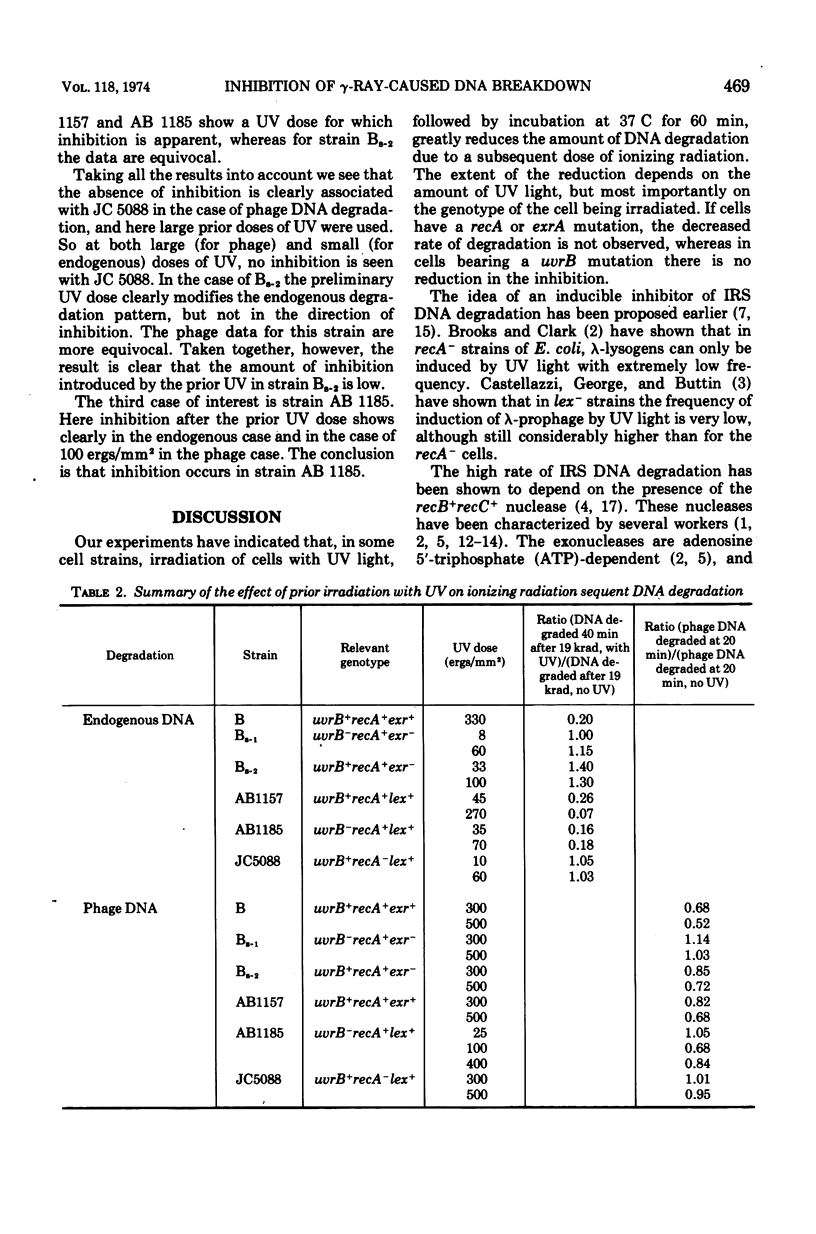Abstract
When Escherichia coli cells are gamma irradiated they degrade their deoxyribonucleic acid (DNA). The DNA of previously gamma-irradiated T4 phage is also degraded in infected cells. The amount of degradation is not only dependent on the dose but also on the genotype of the cell. The amount of degradation is less in cells carrying a recB or a recC mutation, suggesting that most of the DNA degradation is due to the recB+ and recC+ gene product (exonuclease V). In some strains a previous dose of ultraviolet (UV) light followed by incubation renders the cells resistant to DNA degradation after gamma irradiation. We have shown this inhibition to take place for infecting T4 phage also. By using six strains of E. coli selected for mutations in the genes recA, exr (or lex), and uvrB, we have been able to show that the preliminary UV treatment produces no change in recA and exr cells for both endogenous DNA degradation and the degradation of infecting irradiated T4 phage DNA, i.e., inhibition was not detected in these strains. On the other hand, wild-type cells and strains carrying mutations of uvrB show inhibition in both types of experiments. Because the recA gene product and the exr+ (lex+) gene product are necessary for the induction of prophage, it is possible that the phenomenon of inducible inhibition requires recA+ and exr+ presence. One interpretation of these results is that an inducible inhibitor may be controlled by the exr gene.
Full text
PDF





Selected References
These references are in PubMed. This may not be the complete list of references from this article.
- Barbour S. D., Clark A. J. Biochemical and genetic studies of recombination proficiency in Escherichia coli. I. Enzymatic activity associated with recB+ and recC+ genes. Proc Natl Acad Sci U S A. 1970 Apr;65(4):955–961. doi: 10.1073/pnas.65.4.955. [DOI] [PMC free article] [PubMed] [Google Scholar]
- Brooks K., Clark A. J. Behavior of lambda bacteriophage in a recombination deficienct strain of Escherichia coli. J Virol. 1967 Apr;1(2):283–293. doi: 10.1128/jvi.1.2.283-293.1967. [DOI] [PMC free article] [PubMed] [Google Scholar]
- Castellazzi M., George J., Buttin G. [Prophage induction and cell division in E. coli. II. Linked (recA, zab) and unlinked (lex) suppressors of tif-1-mediated induction and filamentation]. Mol Gen Genet. 1972;119(2):153–174. doi: 10.1007/BF00269134. [DOI] [PubMed] [Google Scholar]
- Emmerson P. T. Recombination deficient mutants of Escherichia coli K12 that map between thy A and argA. Genetics. 1968 Sep;60(1):19–30. doi: 10.1093/genetics/60.1.19. [DOI] [PMC free article] [PubMed] [Google Scholar]
- Goldmark P. J., Linn S. An endonuclease activity from Escherichia coli absent from certain rec- strains. Proc Natl Acad Sci U S A. 1970 Sep;67(1):434–441. doi: 10.1073/pnas.67.1.434. [DOI] [PMC free article] [PubMed] [Google Scholar]
- Grady L. J., Pollard E. C. Ionizing radiation-initiated degradation of deoxyribonucleic acid in bacteria. A possible role for defective prophage. Radiat Res. 1968 Oct;36(1):68–86. [PubMed] [Google Scholar]
- JAGGER J. A small and inexpensive ultraviolet dose-rate meter useful in biological experiements. Radiat Res. 1961 Apr;14:394–403. [PubMed] [Google Scholar]
- Lieberman R. P., Oishi M. Formation of the recB-recC DNase by in vitro complementation and evidence concerning its subunit nature. Nat New Biol. 1973 May 16;243(124):75–77. [PubMed] [Google Scholar]
- Low B. Formation of merodiploids in matings with a class of Rec- recipient strains of Escherichia coli K12. Proc Natl Acad Sci U S A. 1968 May;60(1):160–167. doi: 10.1073/pnas.60.1.160. [DOI] [PMC free article] [PubMed] [Google Scholar]
- Marsden H., Ginoza W., Pollard E. C. Effects of ionizing radiation on the capacity of Escherichia coli to support bacteriophage T4 growth. J Virol. 1972 Jun;9(6):1004–1016. doi: 10.1128/jvi.9.6.1004-1016.1972. [DOI] [PMC free article] [PubMed] [Google Scholar]
- Mount D. W., Low K. B., Edmiston S. J. Dominant mutations (lex) in Escherichia coli K-12 which affect radiation sensitivity and frequency of ultraviolet lght-induced mutations. J Bacteriol. 1972 Nov;112(2):886–893. doi: 10.1128/jb.112.2.886-893.1972. [DOI] [PMC free article] [PubMed] [Google Scholar]
- Ogawa H., Shimada K., Tomizawa J. Studies on radiation-sensitive mutants of E. coli. I. Mutants defective in the repair synthesis. Mol Gen Genet. 1968 May 3;101(3):227–244. doi: 10.1007/BF00271625. [DOI] [PubMed] [Google Scholar]
- Oishi M. An ATP-dependent deoxyribonuclease from Escherichia coli with a possible role in genetic recombination. Proc Natl Acad Sci U S A. 1969 Dec;64(4):1292–1299. doi: 10.1073/pnas.64.4.1292. [DOI] [PMC free article] [PubMed] [Google Scholar]
- Pollard E. C., Randall E. P. Studies on the inducible inhibitor of radiation-induced DNA degradation of Escherichia coli. Radiat Res. 1973 Aug;55(2):265–279. [PubMed] [Google Scholar]
- Unger R. C., Clark A. J. Interaction of the recombination pathways of bacteriophage lambda and its host Escherichia coli K12: effects on exonuclease V activity. J Mol Biol. 1972 Oct 14;70(3):539–548. doi: 10.1016/0022-2836(72)90558-x. [DOI] [PubMed] [Google Scholar]
- Youngs D. A., Bernstein I. A. Involvement of the recB-recC nuclease (exonuclease V) in the process of x-ray-induced deoxyribonucleic acid degradation in radiosensitive strains of Escherichia coli K-12. J Bacteriol. 1973 Feb;113(2):901–906. doi: 10.1128/jb.113.2.901-906.1973. [DOI] [PMC free article] [PubMed] [Google Scholar]


